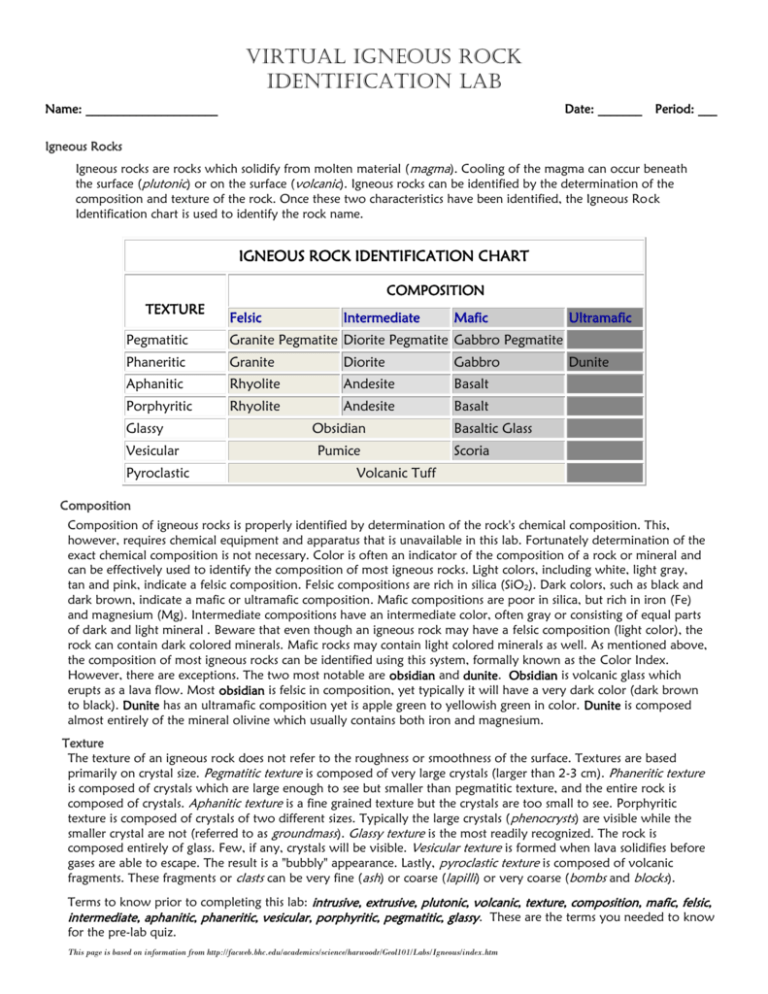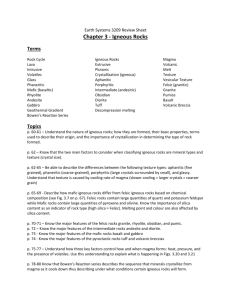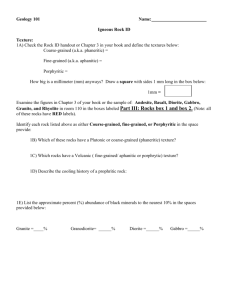Igneous Rocks - Dr. Dent`s Domain
advertisement

Virtual Igneous Rock Identification Lab Name: _____________________ Date: _______ Period: ___ Igneous Rocks Igneous rocks are rocks which solidify from molten material ( magma). Cooling of the magma can occur beneath the surface (plutonic) or on the surface (volcanic). Igneous rocks can be identified by the determination of the composition and texture of the rock. Once these two characteristics have been identified, the Igneous Rock Identification chart is used to identify the rock name. IGNEOUS ROCK IDENTIFICATION CHART COMPOSITION TEXTURE Felsic Intermediate Mafic Pegmatitic Granite Pegmatite Diorite Pegmatite Gabbro Pegmatite Phaneritic Granite Diorite Gabbro Aphanitic Rhyolite Andesite Basalt Porphyritic Rhyolite Andesite Basalt Glassy Vesicular Pyroclastic Obsidian Pumice Ultramafic Dunite Basaltic Glass Scoria Volcanic Tuff Composition Composition of igneous rocks is properly identified by determination of the rock's chemical composition. This, however, requires chemical equipment and apparatus that is unavailable in this lab. Fortunately determination of the exact chemical composition is not necessary. Color is often an indicator of the composition of a rock or mineral and can be effectively used to identify the composition of most igneous rocks. Light colors, including white, light gray, tan and pink, indicate a felsic composition. Felsic compositions are rich in silica (SiO2). Dark colors, such as black and dark brown, indicate a mafic or ultramafic composition. Mafic compositions are poor in silica, but rich in iron (Fe) and magnesium (Mg). Intermediate compositions have an intermediate color, often gray or consisting of equal parts of dark and light mineral . Beware that even though an igneous rock may have a felsic composition (light color), the rock can contain dark colored minerals. Mafic rocks may contain light colored minerals as well. As mentioned above, the composition of most igneous rocks can be identified using this system, formally known as the Color Index. However, there are exceptions. The two most notable are obsidian and dunite. Obsidian is volcanic glass which erupts as a lava flow. Most obsidian is felsic in composition, yet typically it will have a very dark color (dark brown to black). Dunite has an ultramafic composition yet is apple green to yellowish green in color. Dunite is composed almost entirely of the mineral olivine which usually contains both iron and magnesium. Texture The texture of an igneous rock does not refer to the roughness or smoothness of the surface. Textures are based primarily on crystal size. Pegmatitic texture is composed of very large crystals (larger than 2-3 cm). Phaneritic texture is composed of crystals which are large enough to see but smaller than pegmatitic texture, and the entire rock is composed of crystals. Aphanitic texture is a fine grained texture but the crystals are too small to see. Porphyritic texture is composed of crystals of two different sizes. Typically the large crystals ( phenocrysts) are visible while the smaller crystal are not (referred to as groundmass). Glassy texture is the most readily recognized. The rock is composed entirely of glass. Few, if any, crystals will be visible. Vesicular texture is formed when lava solidifies before gases are able to escape. The result is a "bubbly" appearance. Lastly, pyroclastic texture is composed of volcanic fragments. These fragments or clasts can be very fine (ash) or coarse (lapilli) or very coarse (bombs and blocks). Terms to know prior to completing this lab: intrusive, extrusive, plutonic, volcanic, texture, composition, mafic, felsic, intermediate, aphanitic, phaneritic, vesicular, porphyritic, pegmatitic, glassy . These are the terms you needed to know for the pre-lab quiz. This page is based on information from http://facweb.bhc.edu/academics/science/harwoodr/Geol101/Labs/Igneous/index.htm PART 1: Fill in the following table from these 6 common igneous rocks: (gabbro, diorite, rhyolite, andesite, granite, basalt) Mafic Intermediate Felsic APHANITIC PHANERITIC PART 2: Go to the following website and practice identifying rocks prior to completing the remainder of this assignment.Richard Hardwood at Black Hawk College) PART 3: Fill in the chart below. Sample numbers are linked to pictures of each rock (click on each one to view the sample). PROCEDURE: 1. Determine the overall color of the sample: some examples include pink, light grey, dark grey, black, white, etc. 2. What is the composition of the sample? Mafic, intermediate, or felsic are your options 3. What is the texture of the sample? Aphanitic, phaneritic, vesicular, glassy, porphyritic, and pegmatitic are your options 4. What are the major minerals present in the rock? Refer to Rock Classification Chart handout or table within the lab or textbook. a. Mafic: plagioclase, pyroxene, olivine b. Intermediate: plagioclase, amphibole, biotite c. Felsic: potassium feldspar, quartz, biotite, muscovite 5. What is the rock name – refer to the list on the first page of this handout. There is only one of each! Sample # 1 Color Composition Texture Major Minerals 2 3 4 5 6 7 8 9 10 11 12 This page is based on information from http://facweb.bhc.edu/academics/science/harwoodr/Geol101/Labs/Igneous/index.htm Rock Name PART 4: Post-Lab Assignment Objective: See the relationships between the terms and the rocks. There will be more than one rock listed for each. Procedure: Classify the following rocks into the categories listed below: Granite, basalt, obsidian, rhyolite, pumice, scoria, andesite, diorite, gabbro 1. List all of the rocks that are felsic. 2. List all of the rocks that are intermediate. 3. List all of the rocks that are mafic. 4. List all of the rocks that are intrusive. 5. List all of the rocks that are extrusive. 6. List all of the rocks that are volcanic. 7. List all of the rocks that are plutonic. 8. List all of the rocks that can be aphanitic. 9. List all of the rocks that can be phaneritic. 10. List all of the rocks that can be vesicular. 11. List all of the rocks that can be porphyritic. 12. List all of the rocks that can be pegmatitic. This page is based on information from http://facweb.bhc.edu/academics/science/harwoodr/Geol101/Labs/Igneous/index.htm








